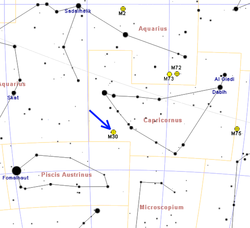| Messier 30 | |
|---|---|
 Open cluster Messier 30 in Capricornus | |
| Observation data (J2000 epoch) | |
| Class | V [1] |
| Constellation | Capricornus |
| Right ascension | 21h 40m 22.12s [2] |
| Declination | –23° 10′ 47.5″ [2] |
| Distance | 27.14 ± 0.65 kly (8.3 ± 0.20 kpc) [3] [4] |
| Apparent magnitude (V) | 7.2 [5] |
| Apparent dimensions (V) | 12'.0 |
| Physical characteristics | |
| Mass | 1.6×105 [6] M☉ |
| Metallicity | [Fe/H] = –2.27 [7] dex |
| Estimated age | 12.93 Gyr [8] |
| Other designations | M30, NGC 7099, GCl 122 [9] |
Messier 30 (also known as M30, NGC 7099, or the Jellyfish Cluster) is a globular cluster of stars in the southeast of the southern constellation of Capricornus, at about the declination of the Sun when the latter is at December solstice. [a] It was discovered by the French astronomer Charles Messier in 1764, who described it as a circular nebula without a star. In the New General Catalogue, compiled during the 1880s, it was described as a "remarkable globular, bright, large, slightly oval." It can be easily viewed with a pair of 10×50 binoculars, [10] forming a patch of hazy light some 4 arcminutes wide that is slightly elongated along the east–west axis. [10] With a larger instrument, individual stars can be resolved and the cluster will cover an angle of up to 12 arcminutes across graduating into a compressed core about one arcminute wide that has further star density within. [11]
Contents
It is longest observable (opposed to the Sun) in the first half of August. [b] [10]
M30 is centered 27,100 light-years away from Earth with a roughly 2.5% margin of error, [4] and is about 93 light-years across. [11] The estimated age is roughly 12.9 billion years [8] and it forms a mass of about 160,000 times the mass of the Sun (M☉). [6] The cluster is following a retrograde orbit (against the general flow) through the inner galactic halo, suggesting that it was acquired from a satellite galaxy rather than forming within the Milky Way. [8] It is in this epoch 22.2 kly (6.8 kpc), from the center of the galaxy, compared to an estimated 26 kly (8.0 kpc) for the Sun. [12]
The cluster has passed through a dynamic process called core collapse and now has a concentration of mass at its core of about a million times the Sun's mass per cubic parsec. This makes it one of the highest density regions in the Milky Way galaxy. Stars in such close proximity will experience a high rate of interactions that can create binary star systems, as well as a type of star called a blue straggler that is formed by mass transfer. [3] A process of mass segregation may have caused the central region to gain a greater proportion of higher mass stars, creating a color gradient with increasing blueness toward the middle of the cluster. [13]

